Nissan Violet
| Nissan Violet/Stanza | |
|---|---|
 1987 Nissan Stanza GXE (T12, U.S) | |
| Overview | |
| Manufacturer | Nissan |
| Production | 1977–1992 |
| Assembly |
Oppama Plant and Hiratsuka Plants, Kanagawa, Japan Rosslyn, Gauteng, South Africa |
| Body and chassis | |
| Class | Compact |
| Chronology | |
| Successor |
Nissan Altima (USA) Nissan Bluebird Nissan Primera (Europe) |
The Nissan Violet appeared in Japan in 1973, and was exclusive to Japanese Nissan dealerships called Nissan Cherry Store as a larger companion to the Nissan Cherry.
The second generation was then split into two additional lines in 1977, and was called the Nissan Auster and the Nissan Stanza. All three bore the A10 series identifier, and were built in Japan at both Hiratsuka and Yokosuka assembly plants to meet demand. The Stanza was exclusive to Japanese Nissan dealerships called Nissan Satio Store as a larger companion to the smaller Nissan Sunny, and the Auster triplet was exclusive to Nissan Prince Store locations as a larger companion to the Nissan Langley.
A new third generation front-wheel drive model was launched in 1981, changing the series name again to T11, and shared the platform with the Compact MPV Nissan Prairie/Multi/Stanza Wagon. Final versions were Nissan Bluebirds series U12 rebadged for some international markets. In most export markets the car was originally sold as the Datsun 140J or 160J depending on the engine; this name was then gradually changed to Nissan Stanza in most markets.
The Stanza/Auster/Violet were discontinued in 1992. The Stanza was replaced by the Nissan Altima in North America; the Stanza was replaced by the Nissan Bluebird in Japan, and by the Primera in Europe.
710 series (1973–1977)
| Nissan Violet 710 series | |
|---|---|
|
Datsun Violet Hardtop Coupe (710, Japan) | |
| Overview | |
| Also called | |
| Production |
Japan: 1973–1977 Taiwan: 1973–1979 Mexico: 1974–1978 |
| Body and chassis | |
| Body style | |
| Layout | FR layout |
| Powertrain | |
| Engine |
1.4 L L14 I4 1.6 L L16/L16E/L16P I4 1.8 L L18 I4 2.0 L L20B I4 |
| Transmission |
|
| Dimensions | |
| Wheelbase | 2,450 mm (96 in) |
| Length | 4,120 mm (162 in) |
| Width | 1,580 mm (62 in) |
| Height | 1,375 mm (54.1 in) |
| Curb weight | 1,005 kg (2,216 lb) |
The Japanese: Nissan Violet, was a smaller version of the Datsun Bluebird 610, which was sold outside Japan under Nissan's Datsun brand as the Datsun 140J/160J — except in the United States where it was marketed simply as the Datsun 710. This model was built as a two-door saloon, two-door coupé, four-door fastback, (and later as a regular four-door saloon), estate, and as a van. Introducing the Violet allowed Nissan to moderately increase the dimensions of the existing Datsun Bluebird.
The sporty SSS model has rear independent suspension, others have a leaf sprung rear. Aside from the different name, the North American market 710 received large separate bumpers rather than the curved, fitted pieces used in other markets to comply with United States bumper legislation in 1973. Early export market cars were fitted with tiny chrome cover plates to hide the holes left on top of the front fenders by the Japanese market rear view mirrors. The most powerful version offered in Japan was the fuel injected 1600 SSS-E with 110 PS (81 kW) JIS at 6200 rpm.[1] In export markets the twin-carb 160J SSS claimed 95 PS (70 kW) DIN, five more than the regular 160J.[2]

This vehicle was available for sale around the same time as the first generation Toyota Carina. The original four-door bodywork was quite swoopy, with a fastback line. It was one of the first Nissan products to introduce "coke bottle styling", an appearance that had debuted internationally during the 1960s and 1970s. Its appearance was controversial, which led to a certain amount of customer complaints at the limited rear vision and dark rear cabin - especially for children. Taxi companies refused to purchase any more Violets, and in a rather drastic facelift for 1976 Nissan replaced the entire rear end (including the roof panel and the doors) with more traditional, notchback bodywork. This provided more space and comfort for passengers, while also minimizing blind spots.[3]
This version also received a new chassis code, 711. The two-door versions did not undergo this modification.[4] The two-door sedan was discontinued, while the coupé did receive the new chassis code and remained on sale alongside the four-door 711 and the 710 Van.[1]
- North America
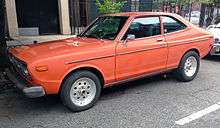
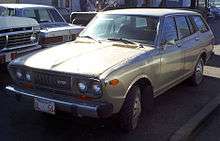
In the United States and Canada, the car was sold simply as the "Datsun 710". Two- or four-door sedans, a two-door coupé, and a five-door station wagon were available. All received the 2-liter L20B engine, with 97 or 94 hp (72 or 70 kW) (SAE Net) in 49-state and Canadian trim versus California-spec cars. The federal/Canadian version took leaded fuel and depended on an EGR system for pollution control, while the California cars have a catalytic converter and require unleaded gasoline. Gross horsepower ratings are 110 and 107 respectively.[5][6] Mysteriously, while wagons usually have a smaller gas tank of 11.9 US gal (45.05 L) rather than 13.2 US gal (49.97 L), the California-market 710 wagon has the same size gas tank as the sedans and hardtops.[5]
Introduced for the 1974 model year, the 710 only saw very light modifications for 1975. The steering was adjusted to decrease driver effort, while noise levels were reduced, and gear ratios were adjusted to boost gas mileage. Externally, the bumper overriders received a slight chrome molding in the middle.[7]
Foreign assembly
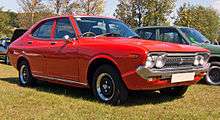
- Taiwan
In Taiwan the Violet was introduced in 1973 under the name Yue Loong Violet and replaced the successful Datsun Bluebird there for nine years. The Yue Loong Violet was usually offered with the OHV J16 engine. The VIP Brougham was a luxury version of the Violet with leather seats and wood interior. Official successor was the Yue Loong Elite 601 which was a sister model to the Nissan 200SX.
- Mexico
This car was assembled at Nissan's Mexico assembly plant located in CIVAC near Cuernavaca from 1973 (as 1974 model-year) to 1978, only with the 1.6-liter engine (160J) and it was known (as the previous generations Datsun Bluebird) as the Datsun Sedan (only as a four-door sedan) and Datsun Guayín (guayín means "station wagon" in Mexican Spanish). It was offered with an optional three-speed automatic gearbox for the model year 1978, whereas in previous years it had only been available with a four-speed manual transmission. It is sometimes referred to as the "bolillo" (white bread) because of its rounded design.
- New Zealand
New Zealand, as a result of the government's temporary lift of import licensing restrictions (the result of high consumer demand for cars, which local CKD assemblers and built-up importers could not meet with the usual licensing restrictions and high import duties of up to 55%, plus sales tax up to 60%) saw considerable CBU imports of the Datsun 140J four-door sedan and 160J two-door during 1973 and 1974.
Due to the short notice and short timeframe of the licence requirement relaxation, the cars imported differed slightly in specification from shipment to shipment - some had Japanese market amber front park lights, front guard-mounted exterior rear view mirrors and 'Violet' badges; later units had clear lenses and 140J/160J badging.
Several hundred 140J sedans entered New Zealand through the Port of Timaru for the South Island market[8] and all were presold before they arrived. All were keenly sought-after and hard to secure as they were better specified as standard (tinted glass, AM pushbutton radio, etc.) than the NZ-assembled CKD kit imported models, which consisted of the Datsun 1200 sedan and wagon, and 180B (Bluebird) and 260C (Cedric) sedans.
Almost-new 140Js were often resold soon after first registration for hundreds of dollars more than their retail prices, such was the model line's initial popularity. The Japanese assembly quality of the 140J was better than the NZ-built Datsuns of the time which were assembled by outside assembly contractors - Nissan themselves did not open its own 'temporary' plant in Mt Roskill, Auckland, until the mid-1970s and a dedicated, purpose-built factory in Wiri in 1978.
- South Africa
In South Africa, the 1976 "711" facelift arrived inOctober 1976 and continued in production for a while longer than in Japan. It was sold as the Datsun 160U or 180U, depending on engine fitment. Deluxe and SSS sedans as well as an SSS Hardtop were available. A batch of 100 SSS models (some of which were Bluebirds) with special "Mexican" upholstery was also built in 1978.[9]
A10 series (1977–1981)
| Nissan Violet A10 series | |
|---|---|
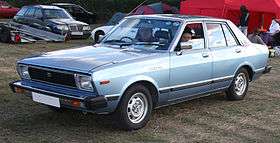 Datsun Violet 140J (UK) | |
| Overview | |
| Also called |
Datsun 510 Datsun Stanza Datsun/Nissan Violet Datsun J-series (1600J/1800J) (South Africa) Datsun 140J/160J/180J Nissan Auster Yue Loong 709/711/712[10] |
| Production |
|
| Assembly |
Japan Australia[11] Rosslyn, Gauteng, South Africa CIVAC, Mexico |
| Body and chassis | |
| Body style |
2/4-door saloon 3/5-door hatchback 5-door station wagon |
| Layout | FR layout |
| Related | Nissan Silvia |
| Powertrain | |
| Engine | |
| Transmission |
4/5-speed manual 3-speed automatic |
| Dimensions | |
| Wheelbase | 2,400 mm (94 in) |
| Length | 4,080–4,310 mm (161–170 in) |
| Width | 1,605–1,620 mm (63–64 in) |
| Height | 1,320–1,410 mm (52–56 in) |
| Curb weight | 870–1,367 kg (1,918–3,014 lb) |
| Chronology | |
| Successor | Nissan AD, all A10-series wagons |
The previous generation Violet was expanded and was joined by two badge engineered versions, called the Japanese: Nissan Auster, and the Stanza for the 1978 model year. The Nissan Auster, which is named for the Latin equalivent of the Greek god notos for the south wind, was a smaller companion to the Nissan Skyline sedan at Nissan Prince Store; Stanza, which is Italian for "room" or "apartment", was introduced as an affordable family car one level above the Nissan Sunny, sold at Nissan Japan dealerships Nissan Satio Store. The third version (Violet) was sold at dealerships called Nissan Cherry Store locations. In Australia, it was called the Datsun Stanza, and in Canada and the United States it was the Datsun 510, a name which recalled the successes of the previous Datsun 510.

Originally it was only sold with the 1.4 litre A-series engine and the 1.6 litre L, although North American market cars received a two-litre version. In October 1978 the car underwent a facelift, becoming the A11 in the process. At the same time, the L16 engines were replaced by the cross-flow Z16, to meet newer stricter emissions rules.[13] Nissan introduced their emissions control technology with this generation, called NAPS, and the cars received a new chassis code of A11. The more luxurious Stanza was never available with the 1.4 litre engine in Japan, only with a 1.6 until larger engines joined the lineup.

In November 1978 a 1.8 litre engine was added at the top of the line-up, mainly for the domestic Japanese market.[10] The 1800 "NAPS-Z" engine was initially only available in the more luxurious Stanza model.[14]
Five body styles were on offer: two- and four-door saloons, a three-door hatchback coupé ("Violet Openback" and "Auster Multi-Coupé"), a 5-door hatchback (only introduced in August 1979, quite late in the car's production run[15]) and a five-door estate. The five-door liftback Stanza was marketed as the "Stanza Resort" in the Japanese domestic market.[15] The five-door bodywork only became available in the Auster and Violet versions as of April 1980, meaning that they were only built for fourteen months as the car was replaced by the T11 generation in June 1981.[16] The A10/A11 wagon was not replaced in 1981, with the somewhat smaller AD Wagon instead filling its place in the Japanese market.
Transmissions offered were a four-speed manual (in all except for the hatchback models), a five-speed manual (hatchback models only), and a three-speed automatic. This generation was available for sale around the same time as the first generation Toyota Celica Camry and the Honda Accord, which formed direct competitors in the domestic marketplace.
Australia
_GL_sedan_(2015-07-14)_01.jpg)
_GX_sedan_(2015-06-18)_02.jpg)
The Stanza was assembled in Australia from 1978 to 1982, in four-door 1.6 litre four-door saloon form, primarily to fill a gap between the Sunny and 200B. Trims available were "GL", "GX", and sporty "SSS".
While popular with buyers, the Australian Stanza was heavily criticized by the motoring journalists of the day (particularly Wheels Magazine), who regarded the car as being "unadventurous", particularly with regard to its styling and conventional drivetrain.
In 1979, 120 two-door coupé models were assembled in Australia, apparently due to a mix-up with Nissan Australia's kit ordering system. They were released into the market anyway with no promotion, and promptly sold out.
New Zealand
A batch of the A10-series 160J, in three-door hatchback form, were imported to New Zealand when local assemblers could not keep up with demand.
Europe
In the United Kingdom, this generation was marketed as the Datsun Violet, and was sold in 1.4 L "GL" and 1.6 L "GL" engine/trim combinations. No estate models were offered. In the rest of Europe it was usually sold as the 160J (or 140J), a variety of bodystyle and equipment combinations were offered, with a Coupé SSS with twin SU-carburetors available at the top of the lineup. Power outputs were 63 PS (46 kW) for the 140J, 81–83 PS (60–61 kW) for the 160J, and 87 PS (64 kW) for the 160J SSS.[17] A fuel-injected version of the 160J was also available in some European markets, with 86 PS (63 kW).[17]
Taiwan
The A10 Violet was locally assembled in Taiwan by Yue Loong until at least 1985. It was sold as the YLN 709, 711, and 712, depending on which facelift version. In later years (712) it was only available with hatchback bodywork and a 1.4 liter engine.[18]
Mexico
The A10 Violet was produced in Mexico from 1978 (as a 1979 model) to 1984. Initially it was only available as a four-door sedan and a wagon with either a 4-speed manual or an optional 3-speed automatic gearboxes. In early 1979, a two-door sedan was introduced (for the first time in Mexico) with its own distinctive front end (two single rounded headlamps instead of the four of the Datsun Sedán and Datsun Guayín).
After having the eurasian looks, for the 1981 model, the Datsun Sedán and Guayín adopt the looks of the American Datsun 510 with larger bumpers and rectangular headlamps. In early 1981, the five-door hatchback becomes available for the mexican market, where it received the name of "Datsun Samurai". The Datsun Samurai, as the top-of-the-line Datsun model in Mexico, received a more luxurios interior and offered with a new 1.8 L engine (which became optional for the Datsun Sedán and Guayín) to compete with the more successful Volkswagen Caribe (Rabbit/Golf Mk1) and Atlantic (Jetta Mk1).
For the 1983 model-year, the mexican Datsun Sedán received new tailamps, and the entire lineup received new black finished bumpers in base models (the luxury trimmed models had chromed bumpers). In March 1984, the Datsun Sedán, Guayín and Samurai are replaced by the first generation Nissan Tsuru.
North America


In the United States and Canada the Violet was sold as the Datsun 510, to cash in on the popularity of the earlier 510 Bluebird. It was available as a two-door sedan, a five-door hatchback, or a five-door wagon. It was powered by the 2.0 L inline-four L20B engine, although in 1980 California-market cars received the twin-plug Z20 NAPS-Z inline-four of the same displacement.[19] From the 1981 model year, this became the only engine available to the 510. Power is 92 hp (69 kW; 93 PS), and also new for 1981 was a four-speed manual accompanying the existing five-speed.[19] The five-speed was installed in the five-door, while the wagon and the two-door received the four-speed unit. A three-speed automatic was optional on all models.[20]
South Africa
South African-made Violets were sold as the 1600J or 1800J depending on engine fitment. Four-door saloon or station wagon bodywork was available, with the 1800 sedan also available as a sporting SSS model.[21]
Motorsports

The Violet 160J was Nissan's most successful car in the World Rally Championship. It won the Safari Rally in Kenya from 1979 to 1982 consecutively, all with Shekhar Mehta behind the wheel. The 1979 and 1980 winners were powered by an SOHC engine; the 1981 and 1982 winners were Violet GT models with a DOHC engine. These Safari records are only matched by the Toyota Celica GT-Four which won the 1992–95 events. Driven by Timo Salonen, the Violet also won the 1980 Rally New Zealand and the 1981 Rallye Côte d'Ivoire.
WRC Victories
No. Event Season Driver Co-driver Car 1  27th Safari Rally
27th Safari Rally1979  Shekhar Mehta
Shekhar Mehta Mike Doughty
Mike DoughtyDatsun 160J 2  28th Safari Rally
28th Safari Rally1980  Shekhar Mehta
Shekhar Mehta Mike Doughty
Mike DoughtyDatsun 160J 3  11th Motogard Rally of New Zealand
11th Motogard Rally of New Zealand1980  Timo Salonen
Timo Salonen Seppo Harjanne
Seppo HarjanneDatsun 160J 4  29th Safari Rally
29th Safari Rally1981  Shekhar Mehta
Shekhar Mehta Mike Doughty
Mike DoughtyDatsun Violet GT 5  13ème Rallye Côte d'Ivoire
13ème Rallye Côte d'Ivoire1981  Timo Salonen
Timo Salonen Seppo Harjanne
Seppo HarjanneDatsun Violet GT 6  30th Marlboro Safari Rally
30th Marlboro Safari Rally1982  Shekhar Mehta
Shekhar Mehta Mike Doughty
Mike DoughtyDatsun Violet GT
T11 series (1981–1986)
| Third generation (T11) | |
|---|---|
 | |
| Overview | |
| Also called |
Nissan Auster Nissan Violet Liberta Nissan Stanza |
| Production | 1982–1986 |
| Body and chassis | |
| Body style |
3-door hatchback (Auster) 4-door saloon 5-door hatchback |
| Layout | FF layout |
| Related | Yue Loong Feeling 101/102, TW |
| Powertrain | |
| Engine |
1.6 L CA16S I4 1.8 L CA18DE I4 2.0 L Z20E I4 2.0 L CA20E I4 1,680 cc CD17T TD I4 |
| Transmission |
3-speed automatic 5-speed manual |
| Dimensions | |
| Wheelbase | 2,550 mm (100 in) |
| Length | 4,405 mm (173.4 in) |
| Width | 1,665 mm (65.6 in) |
| Height | 1,385 mm (54.5 in) |
| Curb weight | 970 kg (2,140 lb) |
A front-wheel drive Stanza was introduced in 1981 — the first compact-class Datsun to be of that configuration. After 1982, Nissan tried to standardize the Stanza name in its export markets — in addition to phasing out the Datsun marque in favour of Nissan. In the United States, the T11 Stanza with CA20S engine, replaced the 510 for the 1982 model year. The Nissan Prairie was also sold as part of the range, renamed the Stanza Wagon. In 1984, Nissan changed the engine in the Stanza from the carbureted CA20S to the fuel-injected 2.0 L, straight-four CA20E. This car was 1981 Semperit Irish Car of the Year in Ireland.
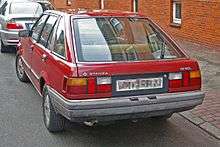
3-door hatchback, 4-door saloon, and 5-door liftback models were produced. Japanese and some other export models were called "Stanza FX", and were offered with 1.6 and 1.8 L engines. The station wagon/delivery van was replaced by the Nissan AD van.
This version was sold in the United Kingdom and Europe as the Nissan Stanza; the range was "L" 1.6 L, "GL" 1.6 L, "SGL" 1.6 L and "SGL" 1.8 L. Some markets (such as Belgium, where it had SGL equipment) also received a 1.7 litre turbodiesel engine with 73 PS (54 kW), beginning with the 1984 model year.[22] It was first sold in Britain from January 1982, alongside the similar-sized rear-wheel drive Bluebird saloons and estates, which later switched to front-wheel drive. This meant that Nissan was in the position of offering traditional rear-wheel drive saloons and estates alongside similar-sized front-wheel drive cars including hatchbacks, as this market sector was in a period of transition in the early 1980s. General Motors had just launched the first front-wheel drive version of the Opel Ascona/Vauxhall Cavalier, which was proving very popular in hatchback and saloon bodystyles. The rear-wheel drive Ford Cortina, Britain's best selling car, was in its final year of production. Front-wheel drive saloons and estates including the Peugeot 305 and Renault 18 were also selling well. It remained on sale in Britain until 1986, after which Nissan sold the first British-built Bluebird as its only product in this market sector.
Nissan-Datsun New Zealand occasionally imported later generation Violets and other models for evaluation, or imported a small production run if additional import licences became available (there was a trading scheme enabling importers to trade unused annual license allocations with each other). One highly specified, five-door, third generation, front-drive model with automatic transmission - and then-rare air conditioning - was imported for an international distributors' conference held in NZ in 1981 and was later used by a company executive's wife before being resold through the company's own dealer network. There was also a small later shipment of cars for public sale (this time without a/c) but, as usual with low-volume imports of this type by Nissan and rivals, most were presold before the ship docked. A number of Stanzas also arrived as used imports from Japan in the late 1980s.
In Indonesia, the T11 Stanza 1.6 L was a popular car taxi in the mid-1980s.
The facelifted Japanese models have an upright nose, similar to that of the Bluebird U11 series. The Stanza was available in Japan at Nissan Satio Store locations, while its badge engineered companion was sold as the Japanese: Violet Liberta five-door hatchback from 1981-1982, then replaced by the smaller Pulsar based Japanese: Liberta Villa three-door hatchback. The Violet Liberta was sold at Nissan Cherry Store locations but only as a five door hatchback.
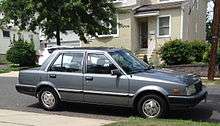
The Auster was a higher specification and sportier version of the Stanza, with the emphasis towards a younger demographic. The three-door hatchback Auster GT-ES was equipped with a five-speed manual transmission. Various trim packages were labeled, 1600 CS-X, Auster JX, GS-X Extra, and the 1800 GS-L Super Saloon. The Auster was exclusive to Nissan Prince Store locations, as a lower cost alternative to the Skyline, but was slightly larger than the Nissan Langley.
- Derivatives
In Taiwan a car closely based on the T11 Nissan Stanza got the name Yue Loong Feeling 101 and in a facelifted version Yue Loong Feeling 102. Both were available as a sedan and in a hatchback variant. The vehicles later got an aggressive redesign with angled headlights and more sporty rearlamps. These versions were the first indigenously developed Taiwanese cars and were even exported in small numbers.
The Stanza T11 series was the only time in the US market that it was rated more-reliable than Toyota Camry, between 1983 and 1986, according to 1983-1986 Consumer Reports magazine. In early years, Toyota Camry had major problems with muffler, while Nissan Stanza did not. Since 1987, Nissan have now fallen behind in reliability to Toyota and Honda.
The Stanza was discontinued in Europe after 1986 model year.
T12 series (1986–1990)
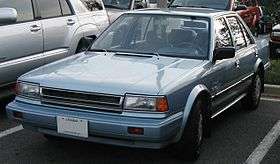 | |
| Overview | |
|---|---|
| Also called |
Nissan Auster Nissan Bluebird Nissan Liberta (Middle East) |
| Production | 1986–1990 |
| Body and chassis | |
| Body style |
4-door saloon 5-door hatchback |
| Layout | FF layout |
| Related |
Nissan Prairie/Axxess Nissan Bluebird U11 |
| Powertrain | |
| Engine |
1.6 L CA16S I4 1.8 L CA18i/CA18DE I4 1.8 L CA18ET I4 1.8 L CA18DET turbo I4 2.0 L CA20S/CA20E I4 2.0 L LD20 diesel I4 |
| Transmission |
4-speed automatic |
| Dimensions | |
| Wheelbase | 2,550 mm (100.4 in) |
| Length | 4,516 mm (177.8 in) |
| Width | 1,689 mm (66.5 in) |
| Height | 1,389 mm (54.7 in) |
| Curb weight | 1,220 kg (2,690 lb) |
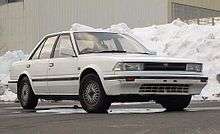

Nissan renewed the Auster and Stanza lines in 1986 (T12 series), introducing squared-off styling. Japan and the US received this model. The US Stanza used the same CA20E engine found in the previous generation. The car was unusually heavy for its class, due to sharing a platform with the contemporary Maxima and as a result of its small engine, underpowered.[23] In part to offset this, some export markets offered turbocharged models, badged "Supremo"; and a cousin, the "Auster XTT".
Europe received a version of the Nissan Auster as a Datsun/Nissan Bluebird replacement. These were built in Sunderland, in the United Kingdom, and badged as the Nissan Bluebird. The estate was the only "real" Bluebird in this range, imported from Japan.
In Middle East, Nissan Stanza T12 was called as Nissan Liberta (not Liberta Villa), an alternative replacement of Nissan Liberta Violet T11.
The Stanza line was not seen in most other export markets after the 1986 model year. The growth of the Sunny and Pulsar models from below meant there was little room for it.
Bluebird (Europe)
The T12 was introduced in Europe in 1985 as a replacement for the U11 Bluebird. From July 1986, the T12 was assembled from parts shipped in from Japan, at Nissan Motor Manufacturing UK . The saloon versions (four door) were available first and the hatchback (five door) became available in January 1987. Using the U11 platform, Bluebird Estates were still sourced from Japan. Although it was not the first Japanese car to be built in Britain (the Honda-based Triumph Acclaim predated it by five years), the Bluebird was instrumental in proving that a British factory could produce vehicles to the same quality standards as those built in Japan. The Bluebird proved so popular that in December 1987 Nissan announced the institution of a third shift, in order to bump production from 29,000 to circa 40,000 cars annually.[24]
The later T72 models replaced the T12 during 1987, followed by a face lift around a year later. This is a point to note, as it is a common mistake to class all pre face lift models as T12s. The face lift models had a more modern and European look, with round front and rear bumpers and the corporate slatted grill. These were eventually built entirely in England. In 1990, Nissan replaced the Bluebird with the Primera series. In the late 1980s and early 90s, Nissan Bluebirds were very commonly seen as taxis, their drivers racking up phenomenal mileage on just routine servicing. The bodyshell's resistance to corrosion has become legendary - it is not uncommon to see Bluebirds as old as 1987 or 1988 vintage still on British roads with virtually no trace of rust at all. However, the Bluebirds' reliability and all-around robustness has ultimately led to its demise – as a banger racers' car of choice.
Almost all petrol T12/T72 Bluebirds came with 8 valve versions of Nissan's CA Engine and either a five-speed manual or a four-speed automatic transmission. The diesel models used the normally aspirated LD20 engine. Performance was average for its class, the 1.6 struggling more with its lower torque characteristics that didn't seem suited to the weight of the car. The turbo models used the CA18ET engine with 135 PS (99 kW; 133 bhp) giving a 0 - 60 mph (97 km/h) time of 8.6 seconds. This is the same engine used in the European Nissan Silvia S12.
As part of the 2016 celebrations marking Nissan’s 30th anniversary in the UK, A group of T12 and T72 owners traveled to Nissan Motor Manufacturing UK [25]
U12 series (1989–1992)
 | |
| Overview | |
|---|---|
| Also called |
Nissan Bluebird (U12) Nissan Pintara (U12) Yue Loong Bluebird 941 (Yulon, TW) |
| Production | 1989–1992 |
| Body and chassis | |
| Body style | 4-door saloon |
| Layout | FF layout |
| Powertrain | |
| Engine | 2.4 L KA24E I4 |
| Transmission |
4-speed automatic |
| Dimensions | |
| Wheelbase | 100.4 in (2,550 mm) |
| Length |
1990-91: 4.57 m (179.9 in) 1992: 4.59 m (180.7 in) |
| Width | 1.70 m (66.9 in) |
| Height | 1.37 m (54.1 in) |
| Chronology | |
| Successor | Nissan Altima (North America) |
In the 1990 model year the American version of the Stanza was replaced by a basic version of the Nissan Bluebird (U12), wearing Stanza badges. In Japan, the Stanza and Auster ranges were effectively replaced by the Nissan Primera for the 1990 model year.
The JDM Bluebird has the rear license plate higher between the tail lights, whereas the Stanza's is mounted on the bumper.
The fourth generation Stanza was offered in two trim levels: "XE" and "GXE". The sporty SE model was added for 1992.
The 4th Gen Stanza used the 2.4 L inline-4 Nissan KA24E engine, an upgrade from previous generations in displacement (from 1974 cc to 2398 cc), power (from 94 hp (70 kW) to 138 hp (103 kW)), and torque (from 114 lb·ft (155 N·m) to 148 lb·ft (201 N·m)). The KA engine was not used on Japanese-spec Bluebirds.
The fourth generation Stanza has EPA estimated fuel economy of 18 mpg-US (13 L/100 km; 22 mpg-imp) city and 25 mpg-US (9.4 L/100 km; 30 mpg-imp) highway for the 4-speed automatic transmission. For the 5-speed manual transmission the Stanza has EPA estimated fuel economy of 18 mpg-US (13 L/100 km; 22 mpg-imp) city and 26 mpg-US (9.0 L/100 km; 31 mpg-imp) highway.[26]
The Stanza was discontinued after the 1992 model year and replaced by the American-built Altima, also Bluebird-based. The last American Stanza rolled off the assembly line on 27 March 1992, though its name would live on in the first generation Altima, technically known as the "Nissan Stanza Altima".
References
- 1 2 自動車ガイドブック [Automobile Guide Book] (in Japanese). Japan: Japan Automobile Manufacturers Association. 23: 120–121. 1976-10-20. 0053-760023-3400. Missing or empty
|title=(help) - ↑ Datsun 1977 (catalog) (in Flemish), Aartselaar, Belgium: N.V. Datsun Belgium S.A., 1977, p. 11
- ↑ Howard, Tony, ed. (October 1976). "News Models". SA Motor. Cape Town, South Africa: Scott Publications: 70.
- ↑ "Violet = 710 Series". Bryan's Missin' Nissan Genealogy Page. Archived from the original on 2010-09-26.
- 1 2 Datsun saves again in '75 (National Sales Training), 1974, p. 16
- ↑ Datsun: La voiture maximum [Datsun: the maximum vehicle] (catalog) (in French), Nissan Automobile Company (Canada) Ltd., 1975-08-30, p. 9, 99999-01099. 100M EP
- ↑ Datsun saves again in '75, p. 17
- ↑ "Timaru's Artificial Harbour". Rootsweb. 2011-03-24. Retrieved 2011-03-24.
- ↑ Wright, Cedric, ed. (August 1978). "New models: Datsun 'U series' cars revised". CAR (South Africa). Vol. 22 no. 7. Ramsay, Son & Parker (Pty) ltd. p. 13.
- 1 2 Braunschweig, Robert; Büschi, Hans-Ulrich, eds. (March 6, 1980). "Automobil Revue '80". 75. Berne, Switzerland: Hallwag, AG: 534–535.
- ↑ David Boyce, What car is that?: in Australia & New Zealand, Rigby, 1981, page 46
- ↑ Lösch, Annamaria, ed. (1980). World Cars 1980. Pelham, NY: The Automobile Club of Italy/Herald Books. p. 368. ISBN 0-910714-12-6.
- ↑ 別冊CG: 自動車アーカイヴ 80年代の日本 [Car Graphic: Car Archives Vol. 11, '80s Japanese Cars] (in Japanese). Tokyo: Nigensha. 2007. p. 98. ISBN 978-4-544-91018-6.
- ↑ 自動車ガイドブック [Japanese Motor Vehicles Guide Book] (in Japanese). Japan: Japan Automobile Manufacturers Association. 26: 113. 1979-11-01 [1979]. 053-790026-3400. Check date values in:
|year= / |date= mismatch(help); Missing or empty|title=(help) - 1 2 別冊CG: 自動車アーカイヴ 70年代の日本 [Car Graphic: Car Archives Vol. 5, '70s Japanese Cars] (in Japanese). Tokyo: Nigensha. 2007. p. 46. ISBN 978-4-544-09175-5.
- ↑ Car Archives Vol. 11, '80s Japanese Cars, p. 96
- 1 2 Automobil Revue '80, p. 257
- ↑ Mastrostefano, Raffaele, ed. (1985). Quattroruote: Tutte le Auto del Mondo 1985 (in Italian). Milano: Editoriale Domus S.p.A. p. 1172. ISBN 88-7212-012-8.
- 1 2 Hogg, Tony (ed.). "1981 Buyer's Guide". Road & Track's Road Test Annual & Buyer's Guide 1981 (January–February 1981): 89.
- ↑ Datsun: Suggested retail prices for 1981 Datsun Models★ (Sales Training/Dealer Support), Gardena, CA: Nissan Motor Corporation in U.S.A., 1980-09-25, p. 3
- ↑ Haler, Justin, ed. (July 1979). "Economy is the name of the game today". SA Motor. Randburg, South Africa: SA Motor (Pty) Ltd. 17 (7): 34–35.
- ↑ Nissan Gamma [Nissan range] (brochure) (in Flemish), Aartselaar, Belgium: N.V. Nissan Belgium S.A., 1984, p. 1
- ↑ "Maxima History". Retrieved 2006-06-07.
- ↑ Liberali, Sandro, ed. (1987-12-17). "Brevissime" [In short]. Auto Oggi (in Italian). Verona, Italy: Arnoldo Mondadori. 2 (54): 4.
- ↑ http://www.sunderlandecho.com/news/business/bluebirds-fly-in-to-sunderland-s-nissan-plant-1-8026555
- ↑ "EPA Fuel Economy Site". Retrieved 2008-11-17.
External links
| Wikimedia Commons has media related to Nissan Violet. |
| « previous — Nissan road car timeline, United States and Canadian markets, 1980s–present | ||||||||||||||||||||||||||||||||||||||
|---|---|---|---|---|---|---|---|---|---|---|---|---|---|---|---|---|---|---|---|---|---|---|---|---|---|---|---|---|---|---|---|---|---|---|---|---|---|---|
| Type | 1980s | 1990s | 2000s | 2010s | ||||||||||||||||||||||||||||||||||
| 0 | 1 | 2 | 3 | 4 | 5 | 6 | 7 | 8 | 9 | 0 | 1 | 2 | 3 | 4 | 5 | 6 | 7 | 8 | 9 | 0 | 1 | 2 | 3 | 4 | 5 | 6 | 7 | 8 | 9 | 0 | 1 | 2 | 3 | 4 | 5 | 6 | ||
| Subcompact | Micra | Micra | ||||||||||||||||||||||||||||||||||||
| Versa (hatchback) | Versa Note | |||||||||||||||||||||||||||||||||||||
| 210 | Sentra | Sentra | Sentra | Sentra | Versa (sedan) | Versa (sedan) | ||||||||||||||||||||||||||||||||
| Compact | 310 | Sentra | ||||||||||||||||||||||||||||||||||||
| 510 | Stanza | Stanza | Stanza | Altima | Altima | |||||||||||||||||||||||||||||||||
| 810 | Maxima | Maxima | ||||||||||||||||||||||||||||||||||||
| Mid-size | Sentra | Sentra | ||||||||||||||||||||||||||||||||||||
| Leaf | ||||||||||||||||||||||||||||||||||||||
| Altima | Altima | Altima | ||||||||||||||||||||||||||||||||||||
| Maxima | Maxima | Maxima | ||||||||||||||||||||||||||||||||||||
| Full-size | Maxima | Maxima | Maxima | |||||||||||||||||||||||||||||||||||
| Sport compact | Pulsar NX | Pulsar NX | NX | 200SX | Altima Coupe | |||||||||||||||||||||||||||||||||
| 200SX | 200SX | 240SX | 240SX | |||||||||||||||||||||||||||||||||||
| Sports | 280ZX | 300ZX | 300ZX | 350Z | 370Z | |||||||||||||||||||||||||||||||||
| GT-R (R35) | ||||||||||||||||||||||||||||||||||||||
| Note | Vehicle sold only in Canada. | |||||||||||||||||||||||||||||||||||||
| Datsun road car timeline, United States and Canadian markets, 1958–1979 — next » | ||||||||||||||||||||||||
|---|---|---|---|---|---|---|---|---|---|---|---|---|---|---|---|---|---|---|---|---|---|---|---|---|
| Type | 1950s | 1960s | 1970s | |||||||||||||||||||||
| 8 | 9 | 0 | 1 | 2 | 3 | 4 | 5 | 6 | 7 | 8 | 9 | 0 | 1 | 2 | 3 | 4 | 5 | 6 | 7 | 8 | 9 | |||
| Subcompact | F-10 (F10) | 310 (N11) | ||||||||||||||||||||||
| 1000 (B10) | 1200 (B110) | B-210 (B210) | 210 (B310) | |||||||||||||||||||||
| Compact | 710 | 510 (A10) | ||||||||||||||||||||||
| 1000 (210) | 310 | 311 | 312 | 410 | 411 | 510 | 610 | 810 | ||||||||||||||||
| Executive car | Cedric (30) | |||||||||||||||||||||||
| Sports | Fairlady (SPL 212) | Sports 1500 (SPL 310) | Sports 1600 (SPL 311) | 200SX | ||||||||||||||||||||
| Sports 2000 (SRL 311) | 240Z | 260Z | 280Z | 280ZX | ||||||||||||||||||||
| Pick-up | Truck (220) | Truck (320) | Truck (520) | Truck (521) | Truck (620) | |||||||||||||||||||
| SUV | Patrol | |||||||||||||||||||||||